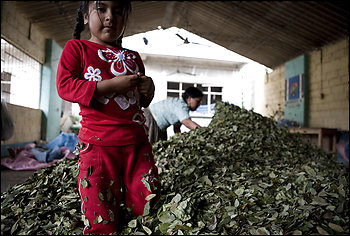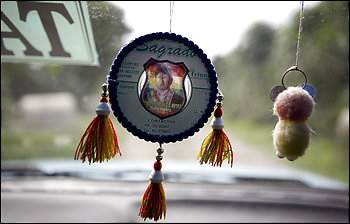Despite U.S. Aid, Coca Cultivation On Rise in Andes
September 3, 2008 - The Washington Post
By Juan Forero and Joshua Partlow, Washington Post Foreign Service
COROICO, Bolivia -- Benito Cocarico admits that some of the coca leaves he grows to sell as tea and a traditional pick-me-up are channeled off into the broad stream of the global cocaine trade. But as he trudges on the muddy trails of his farm, located in a region where the raw material for the drug grows on narrow terraces, he explains how central the crop is to his family's well-being.
"The prices of oranges, mandarins, coffee and other products are too low, and they do not give you enough to survive," said Cocarico, 50, adding that he plans to double the size of his coca crop. "So we are obligated to plant coca."
 (left) A girl plays in a pile of coca leaves at the coca market in the Bolivian jungle town of Chimore as her mother gathers the leaves together into 50 pound bags. (Photos By Evan Abramson For The Washington Post)
(left) A girl plays in a pile of coca leaves at the coca market in the Bolivian jungle town of Chimore as her mother gathers the leaves together into 50 pound bags. (Photos By Evan Abramson For The Washington Post)
Across the Andean region, the size of the coca crop has increased 18 percent in the past five years, a period during which the United States has spent $4 billion on anti-drug programs. With farmers turning to pesticides and modern irrigation to improve crop yields, the amount of cocaine produced in Colombia, Peru and Bolivia -- source countries for nearly all of the global supply -- hovers at 1,100 tons a year, according to a recent U.N. report.
Here in the lush Yungas region of western Bolivia, farmers are allowed by law to plant a total of nearly 30,000 acres of coca -- leaf that is then sold in the domestic market for tea or to be chewed to ward off hunger. But production here far exceeds that threshold, and much of the surplus feeds a cocaine trade thriving in part on the new regional demand of a rising Latin American middle class.
The Andean cocaine supply now exceeds the amount produced in the 1990s, when U.S. policymakers pushed anti-drug aid to the region to counter powerful Colombian cartels. In 1993, when a U.S.-supported police unit shot dead the drug lord Pablo Escobar in his home town of Medellin, the Andes produced 200 fewer tons of cocaine than it did last year.
ad_icon
Click here!
"If you look back at the days of Escobar, the names have changed but there's as much cocaine or more cocaine coming out of the Andes as a whole as in the peak anti-Medellin war on drugs," said John Walsh of the Washington Office on Latin America, a policy group critical of U.S. anti-drug policies in the region. "We're talking almost 20 years later."
So far this decade, the United States has invested nearly $8 billion in the drug war, funding manual eradication efforts in Bolivia and neighboring Peru and an aerial herbicide-spraying program in Colombia that has covered more than 2.5 million acres since 2000.
In Colombia, where the United States has spent the most, coca cultivation rose 27 percent from 2006 to 2007, to about 245,000 acres. That accounts for more than 50 percent of all coca production in the region. Coca plantings in Bolivia and Peru also increased by about 5 percent each. Taken together, the United Nations reported a 16 percent increase in Andean coca production in 2007.
"It has been three steps forward, two steps back," said David Murray, chief scientist at the Office of National Drug Control Policy in Washington. "But there actually has been progress. Throughout the Andes and in Colombia."
 (left) A taxi ornament in Chapare pictures Bolivian President Evo Morales, a former coca grower, under the word "sacred." (Evan Abramson)
(left) A taxi ornament in Chapare pictures Bolivian President Evo Morales, a former coca grower, under the word "sacred." (Evan Abramson)
Murray attributed the reported increase in coca cultivation to a change in U.N. methodology. The anti-narcotics aid to Colombia has helped strengthen the central government there by weakening drug-trafficking rebel and paramilitary groups, Murray said, while reports from law enforcement agencies in the United States indicate that it has become more difficult to buy the drug.
"They're losing ground, is our argument, they're smaller plots [of coca], they're more remote, they're more labor-intensive, and it's more difficult for them to extract a cocaine living out of this," he said. "The cocaine market is in decline."
While Colombian President Álvaro Uribe is revered in Washington for his tough stance against cocaine trafficking, the Bush administration has been sharply at odds with Bolivia's president, Evo Morales, a former coca farmer who still heads the coca growers federation. Morales rose to power on the strength of his leadership of coca growers, who organized against what they saw as damaging U.S.-sponsored eradication policies.
"There's no question that Evo Morales has intentionally weakened the effort that existed when he took office, and the increase in cultivation partly reflects that," said John P. Walters, the White House drug policy chief.
Since being elected president in December 2005, Morales has promoted the coca leaf as a symbol of Bolivian nationalism, while stressing the need to fight cocaine production. His government continues to eradicate illegal coca -- plots with known links to the drug trade or grown in national parks, for example. Under Morales, the amount of cocaine seized each year has risen to the nearly 20 tons confiscated so far this year, according to government statistics.
Morales also supports a four-year-old policy that allows coca farmers in Bolivia's Chapare region, where coca cultivation had previously been illegal, to grow the plant on a third of an acre of their land, called a cato. Critics say the policy has led to a spike in coca production because coca farmers, or cocaleros, do not fear punishment if they exceed the limit. The U.N. figures show that coca cultivation last year in Bolivia surpassed the 50,000-acre limit that the government allows by nearly 50 percent.
"What we've had in Bolivia is basically this perception on the part of cocaleros that one cato per family translates into one cato per person," said Eduardo Gamarra, a Bolivian-born expert on the coca industry who teaches Latin American affairs at Miami's Florida International University. "The net effect has been a net growth."
Among the coca growers in the Chapare, Morales is perceived as a folk hero. On the wall of the coca growers union office in the lowland jungle town of Chimore, the words "Evo Yes!" are painted next to a portrait of Che Guevara, the Argentine-born revolutionary figure. In the back of the office, workers stuff coca leaves into 50-pound bags that are then loaded onto waiting buses.
"Before, it was a tremendous fight. We planted coca and the authorities took it away," said Luis Endara, secretary general of the coca growers union in Chimore. "Now there is freedom. The army doesn't bother us anymore. Every community now controls itself."
ad_icon
Between 1997 and 2003, 60 people were killed in the Chapare in fighting between coca growers and Bolivian authorities, and more than 700 others were injured, according to the Andean Information Network, a research group based in Bolivia. Today, most of the far more infrequent confrontations involve rocks or tear gas. No one has been killed in recent months.
"Before, the police persecuted us," said Flora Sanabria, 33, who sat along a road next to her drying coca leaves. She also grows bananas and oranges, but coca, with its three to four harvests a year, provides a steady income for her family. "We are much better off. We have a cato of coca now, and before, we had almost nothing."
The rebound of coca in Bolivia, combined with increased cocaine demand from Latin American countries such as Brazil, has fueled the drug trade.
Bolivia's vice minister of social defense, Felipe Cáceres, said that in the past few years, the number of drug traffickers working the Bolivian-Brazilian border has risen fivefold to between 50 and 60. "Unfortunately," he said, "the demand of the drug in Brazil has increased spectacularly."
Domestic consumption in Bolivia -- mostly as tea or leaves for chewing -- accounts for 2.5 percent of Bolivia's gross domestic product, five times as much as in Peru or Colombia. But the Bolivian government's plans to industrialize coca -- turning coca into toothpaste, crackers, liquor and other products for export -- have failed to materialize.
Meanwhile, the clandestine labs used to produce Bolivian cocaine are proliferating beyond the main coca-growing regions of Chapare and Yungas, according to René Sanabria Oropeza, the head of the Bolivian drug police. His police have been finding coca-processing labs even in the poor urban neighborhoods of La Paz and El Alto, a sprawling satellite city adjacent to the capital.
One young man from La Paz, Miguel Ángel, who asked that his last name not be used, explained that traffickers now pay neighborhood residents to process coca in their homes. His family recently received $500 for allowing a group of men to use their kitchen to process coca leaves for a week.
"They said, 'We're in your house now, but we'll go to another house,' " Miguel Ángel said. "That is how they keep from getting caught."